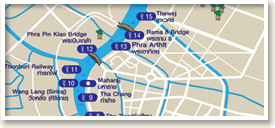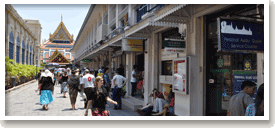



Riverboat Tour
FROM PHRA ARTHIT PIER (walking distance from hotel)
Stop at WANGLANG (SIRIRAJ) PIER
1. Wat Rakang Khositaram: This royal temple was originally built in the Ayuthaya Period but was renovated in the reign of King Rama 1 (1782-1809 AD). During the renovation process a giant bell was unearthed (rakhang in Thai) leading to the temple changing its name. As an important centre of the arts, it is well known for its series of ancient and unique murals located in the exquisite Ho Trai wooden pavilion, which was donated by King Rama 1 to keep the book of the teaching of Buddha. It is also handily compact with everything crammed into a series of narrow alleys.
2. Wanglang Market: Located right after stepping off from Wanglang Pier, the market is easy to reach and a perennial favourite among office workers and locals looking for the hottest street fashions and best prices. It’s also handily compact with everything crammed into a series of narrow alleys.
3. Stop at MAHARAJ PIER
You have a choice to visit The Grand Palace, Wat Phra Kaeo and Bangkok National Museum by taking Chao Phraya Tourist Boat or by walking. The first place many Chinese immigrants settled on arrival in Bangkok.
Stop at THA TIEN PIER
4. Museum of Siam: Opened in December 2007, The Museum of Siam might be set in a former palace that previously housed the Ministry of Commerce but it is a very modern interpretation of a museum. The main focus is as interactive, audio visual driven exhibition entitled “The Story of Thailand,” which traces the history of the country.
5. Tha Tien Market: Due to its location, Tha Tien was originally called Thay Wang Market (the market behind the palace) and was a big trading, transport and cultural centre during the late 18th century. However, a major fire saw the area get its new name (tien means being levelled to the ground) and it suffered a decline in importance. Nowadays, Tha Tien Market is famous for its dry fish and seafood stalls and the chance to see its numerous traditional Rattanakosin-period shop houses, many of which are now home to quaint cafés and restaurants.
6. Flower Market (Pak Klong Talad): Originally a fish market during the King Rama 1 period, it began to solely focus on flowers when the fish traders moved elsewhere during the reign of King Rama 5. Today Pak Klong Talad is the largest wholesale and retail flower market in Bangkok and is home to every colour and type of flower imaginable.
7. Wat Pho: From Riva Surya, our guests have choice to walk from the hotel after visiting Grand Palace as mentioned on a page above or take Chao Phraya Tourist Boat.
8. Wat Arun: One of the most symbolic landmarks in Bangkok, the majestic Prang (or Khmer style tower) of the Temple of Dawn dominates the skyline on the bank of the Chao Phraya River. Construction on the prang first began in the reign of King Rama 2 (1809-1824) and was completed by King Rama 3 (1824-1851).
Stop at RAJAWONGSE PIER
9. Chinatown (Yaowaraj): The first place many Chinese immigrants settled on arrival in Bangkok, this remains the centre for the Thai Chinese population and continues to be a thriving business quarter and trading neighbourhood. The path of the central Yaowaraj Road, which bisects the area is said to resemble a dragon’s curvy body, making it an auspicious location for business.
10. Wat Mangkon Kamalawat: The temple, whose name means dragon lotus, was built in the reign of King Rama 5 in 1871. It was the first, and remains the most important, Chinese temple in Bangkok, especially during important festivals such as Chinese New Year and the annual Vegetarian festival in September-October.

Directions to Hotel
From Suvannabhumi airport, get off Express Way at Yommaraj Exit to Pitsanulok Road and drive to the end of the road, turn left to Samsen road, straight on until Banglumpu intersection, turn left to Phra Sumen Road, passing Phra Sumen Fort on the right about 500 metres, Riva Surya is located on the right. For more information, please call +66 2 6335000.
Weather Forecast




